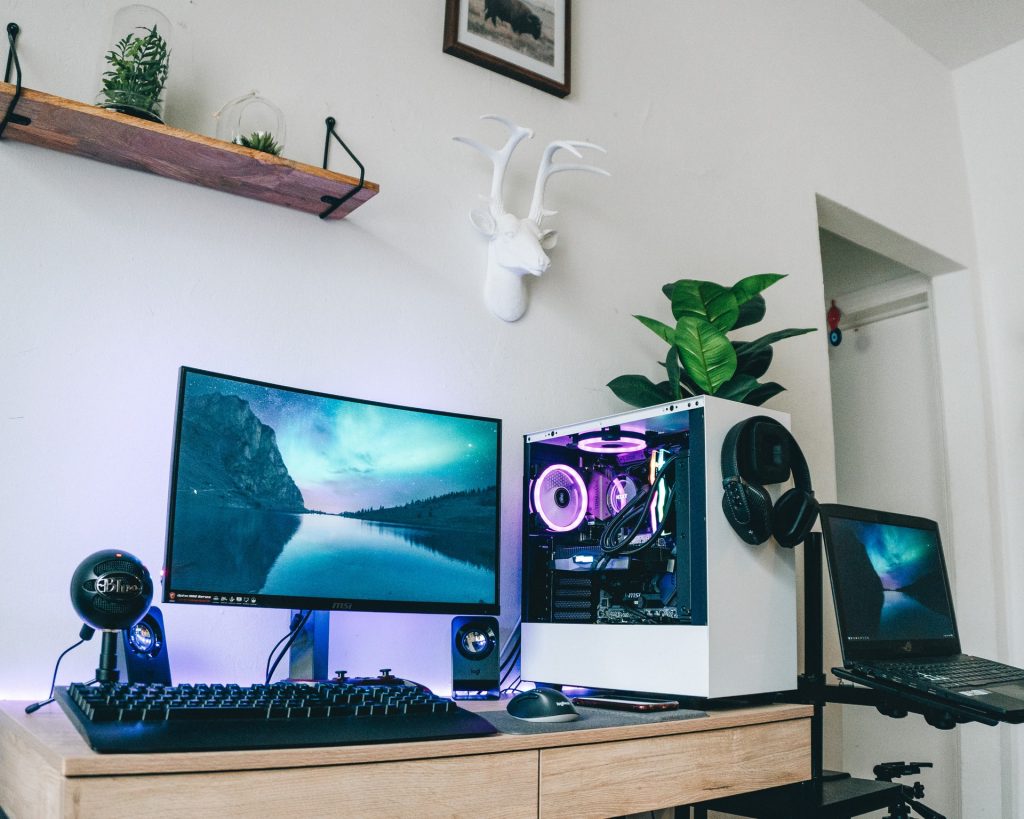Disclosure: This post contains affiliate links and we earn a small commission when you make a purchase or take action after clicking these links.
In just under a decade, esports evolved into this niche, an underground activity that ‘nerds’ did in filthy, smoke-filled internet cafes, into a multi-billion-dollar industry. Selling out entire arenas full of spectators and paying out competitors in prizes that range in the millions of dollars.
So naturally, everyone wants a little slice of that at home, and unlike other professional sports like basketball or football, having a gaming setup in the comfort of your own house is entirely possible, if you have the cash.
Unfortunately, a lot of top-of-the-line gaming PC’s out there are somewhere in the $1500-$2000, basically the price of a second-hand car. And in professional esports where the games take up huge amounts of digital resources, you need top-of-the-line or close to it.
This is why many people choose to build their own rigs, and there’s a large and robust PC-building community out there that seeks to Frankenstein powerful gaming machines at a fraction of the price. It’s in that community that we were able to find a way to create the best gaming PC we could build under $1000, with a little bit to spare.
- Best Budget Gaming Monitor: Asus VP228HE
- Best Budget Gaming Keyboard: STOGA Mechanical Keyboard
- Best Budget Gaming Mouse: Logitech G300S
- Best Budget Gaming Headset: SteelSeries Arctis 1
- Best Budget Gaming CPU: AMD Ryzen 3 3200G
- (Optional) Best Budget Gaming Chair: GTRacing Pro Series Gaming Chair
- Best Budget Gaming Videocard: RTX 2070 Super
- Gaming PC Buying Guide: How To Choose A Gaming PC?
Best Budget Gaming Monitor: Asus VP228HE
Asus’ VP228HE is the company’s best-kept secret: at a measly $89, this budget monitor from the hardware giant offers much for its price, with display qualities that are beyond its price range in 21.5-inch screen size that fully supports 16:9 aspect ratios and resolutions of up to 1920×1080. It even comes with a game-specific mode called, well, The Game, which allows users to brighten up darker regions of the screen without upping the brightness where it shouldn’t.
But it’s not all fun and The Games with this monitor: it does come with some downsides, like its mediocre 60Hz refresh rate. Sure, if you’re just watching Youtube videos or Netflix, this shouldn’t be much of an issue, but for high-octane, fast-paced FPS games, this could put you at a disadvantage. However, the monitor is flicker-free, so it does balance everything out. The monitor’s menus also come with a bit of a learning curve but just breeze through the instruction manuals and you should be fine.
Overall, not even its unimpressive frame rate can scare us away: at $89, you’re getting more than what you’re paying for and then some. Besides, practicing at lower frame rates might even be a good thing because it forces you to develop faster reaction times!
- 21.5 inch screen at under $100
- Supports 16:9 aspect ratios
- Supports 1920×1080 resolutions
- Has game-specific settings
- Mediocre 60hz refresh rate
- The monitor menu needs a little study
- Sub-par frame rates
Best Budget Gaming Keyboard: STOGA Mechanical Keyboard
If click-clacks and backlighting are all that make you happy when it comes to keyboards, then the STOGA mechanical keyboard is the cheapest you can go without sacrificing quality. It’s a stripped-down, no-frills, tenkeyless experience. It does not come with dedicated media controls, dedicated software, or even a program to control the RGB backlights. Instead, it comes with function keys, a QWERTY setup, a space bar….and that’s about it. But again, when you’re on your 7th hour of Warzone, do you really need a dedicated button to open Spotify?
- Sturdy design
- RBG backlighting
- Keys feel sturdy and secure
- Under $50
- Literally just a keyboard, no other frills
Best Budget Gaming Mouse: Logitech G300S
The Logitech G300s is more than just a left-and-right-click: it actually comes with 9 programmable buttons situated near the top of the frame, and its ambidextrous design means that even lefties can join in on the fun. Because it’s a gaming mouse, Logitech made sure that the G300s’ click latency rate is top-of-the-line, making it an acceptable piece of equipment for even the most competitive gamer out there.
It does have a smaller CPI range than other gaming mice in its price range, but its max polling rate is fairly high, keeping the cursor feeling fluid and balancing out the low CPI. Overall, a pretty solid purchase, considering you’re getting professional-gaming-level equipment at casual-gaming prices.
- Top-of-the-line click latency
- 9 programmable buttons
- Ambidextrous design
- High max polling rate
- Sub-par CPI range for its price
- Might not be enough buttons for other types of games
- Good for casual gaming might be lacking for professional gamers
Best Budget Gaming Headset: SteelSeries Arctis 1
At just under $50, the SteelSeries Arctis 1 offers a lot more than its price range: it has the same, robust 40mm audio drivers that you can find in the more expensive Arctis lines from SteelSeries, a removable mic with a 3.5mm connection, and pretty much omni-compatibility with most consoles and your PC.
Of course, at just under $50, don’t expect world-class mic quality, auto-adjust features for the volume, a perfect fit over your ears, or other fancy features that higher-end models offer. But for just under $50, the Arctis 1 doesn’t disappoint. Yes, it’s an imperfect fit but it’s still comfortable, the mic quality is subpar but it’s not garbled, and the audio is still fairly crystal clear; at least, clear enough to hear 11-year-olds call you a Noob in Overwatch.
- 40mm Audio Drivers for under $50
- 3.5mm removable mic
- Omni-compatibility with most consoles
- Ear pads are comfortable enough for casual gaming
- No auto volume adjust feature
- Sub-par mic quality
- Gets uncomfortable after a couple of hours of usage
Best Budget Gaming CPU: AMD Ryzen 3 3200G
If you thought you needed hundreds, maybe even thousands, of dollars for a high-performance CPU that can play any game without setting its casing on fire, well, you’re not wrong. But for just under $100, the AMD Ryzen 3 3200G delivers above-average features that provide more than decent performance for such a low price. The Ryzen 3 3200G provides solid 720p performance thanks to its built-in Vega graphics, a whole lot of CPU power for background tasks, and is versatile enough to fit on most 300-series motherboards.
However, its stock heatsink is pretty bad, so you’re going to invest in a separate heatsink if you’re going to overclock your CPU, and you’ll have to update your motherboard BIOS for compatibility. But the Ryzen 3 3200G does get around these problems by having unlocked multipliers that allow you to fine-tune both your CPU and your graphics if you have a decent enough cooling system, and everyone needs to update their BIOS from time to time anyway.
- Solid 720p performance
- Unlocked multipliers for fine-tuning
- Fits on most 300-series motherboards
- Premium performance for just under $100
- Sub-par heatsink; invest in a separate cooling system for CPU overclocking
- Requires constant BIOS updating
(Optional) Best Budget Gaming Chair: GTRacing Pro Series Gaming Chair
It’s hard to justify shelling out a couple of hundred dollars just for a chair, but if you’re going to be gaming for hours on end, a good, ergonomic chair designed specifically for gaming becomes a great investment.
Luckily, most gaming chairs follow pretty much the same design scheme, and the GTRacing Pro Series Gaming Chair borrows a lot of these design elements and shoves them into the chair, and prices it comparatively lower than other brands.
The GTRacing Pro Series Gaming Chair comes with the requisite neck pillow, lumbar support, and armrests, all of which are adjustable. It comes in seven different color combinations if you want to be fancy and feel like a pro.
- Ergonomic design
- Comes in seven different color combinations
- Adjustable neck pillow, back and arm support
- Relatively lower priced than other gaming chairs
- You’re still spending $150 for a chair. Do you really need it?
With all of these parts put together, we could build the best gaming laptop for under $1000, at just $446.97, which leaves us $552.03 to spare for a decent graphics card. Is that even possible? Well, let us present to you…
Best Budget Gaming Videocard: RTX 2070 Super
The graphics card will always be the most expensive part of any gaming computer, and unfortunately, the law of diminishing returns is pretty much evident the higher you go up the GPU food chain: for every teensy upgrade in performance (which lessens every step up), you shell out more and more money (which increase every step up).
And while it’s tempting to drop a thousand bucks on the latest video card out there, your best bet is to actually go down a couple of notches and settle for a mid-range GPU. This is where the RTX 2070 Super comes in: it’s the perfect GPU for budget gamers who want to build the best gaming PC under $1000 because it offers all the requisite graphics needs of most modern video games, albeit with limits.
The RTX 2070 Super can handle 1440p Ultra on most games, and can even handle medium/high-quality graphics settings on 4K games, but not for extremely graphics-demanding games like Far Cry 6 or Metro Exodus. But it’s decent enough to play most competitive FPS’ and MOBAs.
This graphics card is about 10% slower than its big brother, the 2080 Ti, but it’s also 30% cheaper (see our comment about diminishing returns). And at 30% less, you’re still getting 8GB of GDDR6, DLSS, and ray tracing, so while you might not be able to see your character’s eyes’ reflection from a pane of glass in a snowstorm in-game, it’s going to be a more-than-just-ok graphics card for the price you’re paying.
- Handles 1440p Ultra on most games
- 8GB of GDDR6
- 30% cheaper than the RTX 2080 Ti
- You get what you pay for
- Will probably be obsolete in the next couple of years
- Not the best choice for competitive gaming
- 10% slower than the RTX 2080 Ti
- But hey, you get what you pay for
Note that we didn’t factor in the CPU casing, a table, cables, and other miscellaneous items, which admittedly would place our entire purchase at a little over $1050. But this whole setup leaves you with $22.04 to spare, which is enough to get you a couple of older games on Steam, and a Big Mac.
Gaming PC Buying Guide: How To Choose A Gaming PC?
Are you looking for a gaming PC that will provide an unbeatable gaming experience? You’re in luck. With so many options, knowing which one to choose can be tough. But don’t worry – we’re here to help! In this article, we’ll explore the different components of a gaming PC and how to pick the best one for your needs.
Display
Your gaming PC should be equipped with a good display capable of producing crisp, clear visuals that will help enhance your gaming experience. However, a gaming PC should be sizable enough to differentiate between text, videos, and other content quickly. Suppose you’re looking for the best quality images and visuals. In that case, there are various resolution options such as HD (High Definition), FHD (Full High-Definition), QHD (Quad high definition), or even 4K UHD displays that offer an unparalleled experience of enriched colors and graphics.
Also, check out the display’s response time, as this will determine how quickly the monitor can switch from one image to another, which is essential if you’re playing fast-paced games like first-person shooters.
Processor
The processor is arguably the most essential component of any computer, including a gaming PC. It is responsible for handling all the tasks the computer needs to do, so it needs to be powerful enough to handle all your games without lagging or freezing up. The faster and more powerful the processor is, the better your gaming experience will be. Look for processors with high clock speeds like Intel Core i7 or AMD Ryzen 5/7.
Graphics Card
Another key component of a gaming PC is the graphics card. The graphics card is responsible for rendering 3D images on screen and displaying them in full HD (or higher) resolution. A good graphics card will ensure that your games look smooth and realistic while playing at higher settings or resolutions. You should look for cards from Nvidia GeForce or AMD Radeon series with at least 4GB (preferably 8GB) of dedicated RAM.
RAM
Random Access Memory (RAM) helps your computer access data quickly and efficiently when running multiple programs simultaneously – especially important when playing games with intense visuals or streaming content over Twitch or YouTube. The amount of RAM you need depends on what kind of games you want to play; if you want to play intensive first-person shooters like Call of Duty, then you may want 16GB RAM minimum, while if you plan on playing less-demanding titles like Stardew Valley, then 8GB should suffice.
Storage Capacity
As the HDD is where all games and programs are kept, it’s crucial to have adequate storage room for your gaming data. Consider selecting an HDD with 500GB or more capacity; if you own a few massive games or download excessive high-resolution films, then even larger sizes, such as 1TB, would be recommended. Likewise, SSDs can offer faster read/write speeds than traditional HDDs, although they come at a much higher price.
Refresh Rate
When gaming, the refresh rate of a monitor is paramount to your experience. A higher refresh rate amplifies visuals for smoother performance, but you’ll need to ensure that your graphics card can handle it. To maximize enjoyment and quality of gameplay, aim for at least 60Hz or even 120Hz or more.
Response Time
The response time of a monitor is the key factor in determining how swiftly pixels can switch from one hue to another. Generally speaking, lower response times are preferable; however, for certain types of games like first-person shooters, you’ll require at least 5ms. Higher response times may result in noticeable input lag and put your gaming performance at risk.
Other Peripherals
To round off your gaming setup, consider the various peripherals available. These include top-quality gaming keyboards, mice, headsets, and controllers, which can provide an extra layer of control and audio/visual feedback for a more immersive experience. Make sure to check out all the options before making a purchase decision.
Budget
You should also consider your budget and the types of games you want to play. An entry-level or mid-range graphics card and processor should suffice for basic gaming needs. If you’re looking for more advanced gaming capabilities, like 4K resolution or VR support, you may need a higher-end mode that costs you pennies.
Warranty
Warranty is something that you should take a look at while purchasing a personal gaming computer. Most gaming PCs come with a one-year warranty, and you must try to get the maximum coverage. Also, many companies offer extended warranties, which could be worth looking into if you want something longer-term.
Final Verdict
As a gamer, having a powerful gaming PC is essential if you want an enjoyable experience without lag or slowdown issues during gameplay sessions. When it comes time to buy one, there are three main components that you need to look out for: processor speed, graphics card capabilities, and RAM size/speed. Armed with this knowledge, you’ll be able to shop around confidently and find the perfect gaming PC that meets all your needs!












